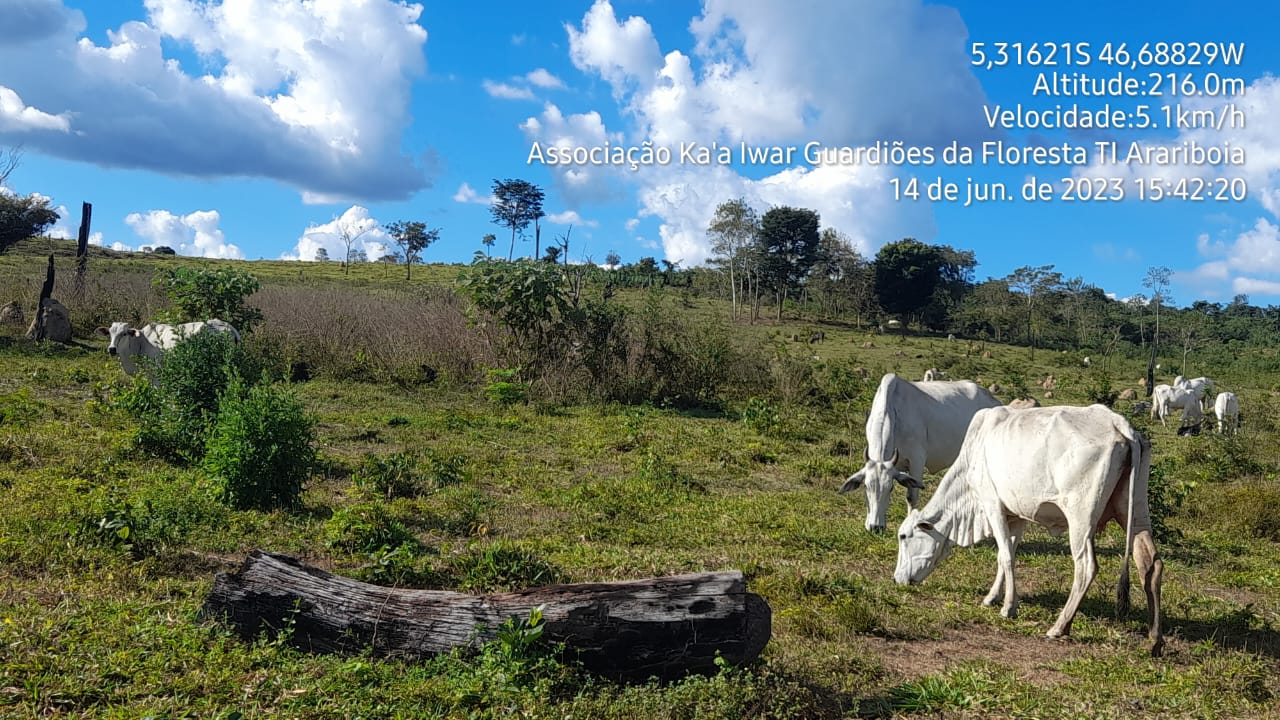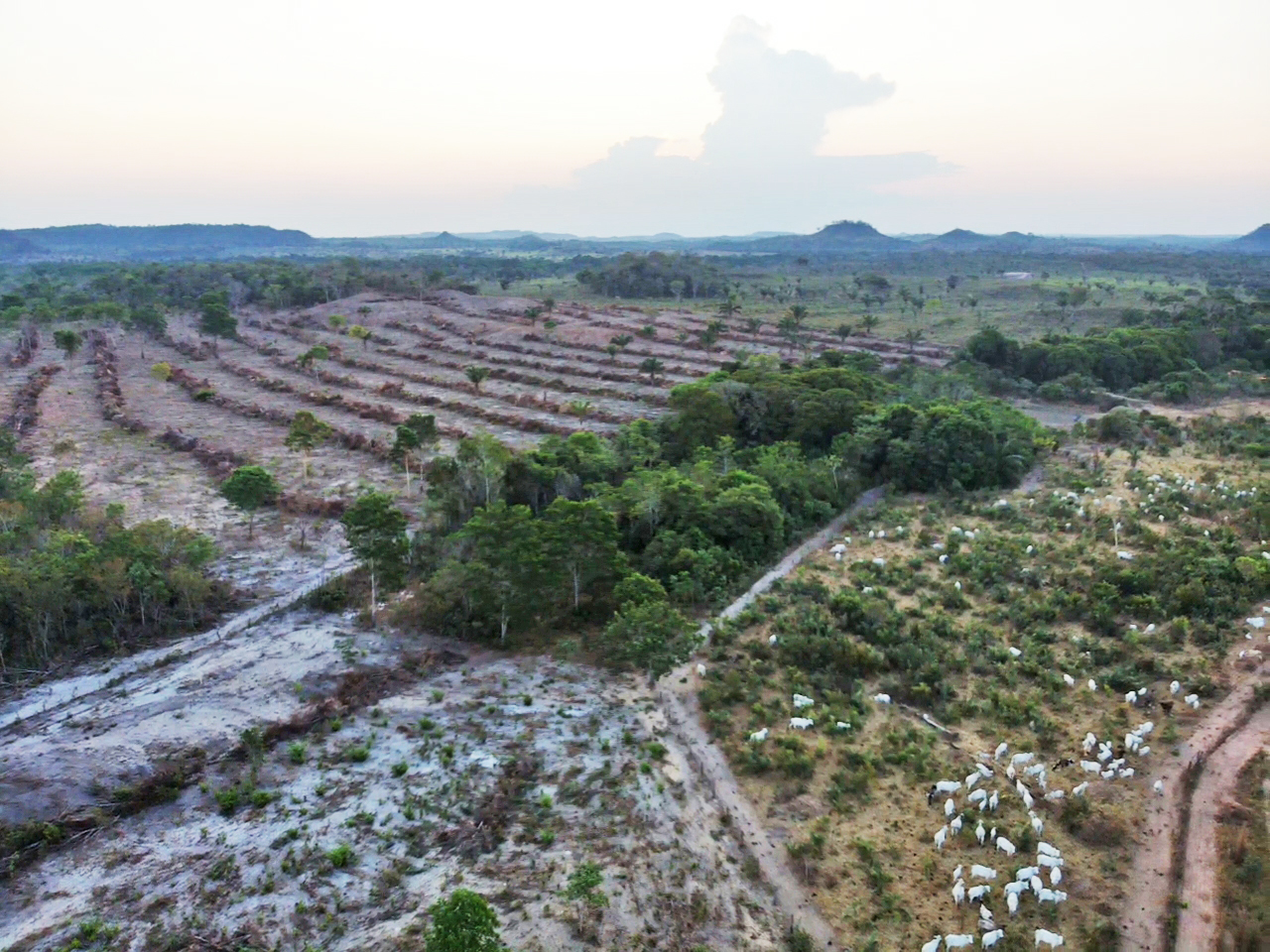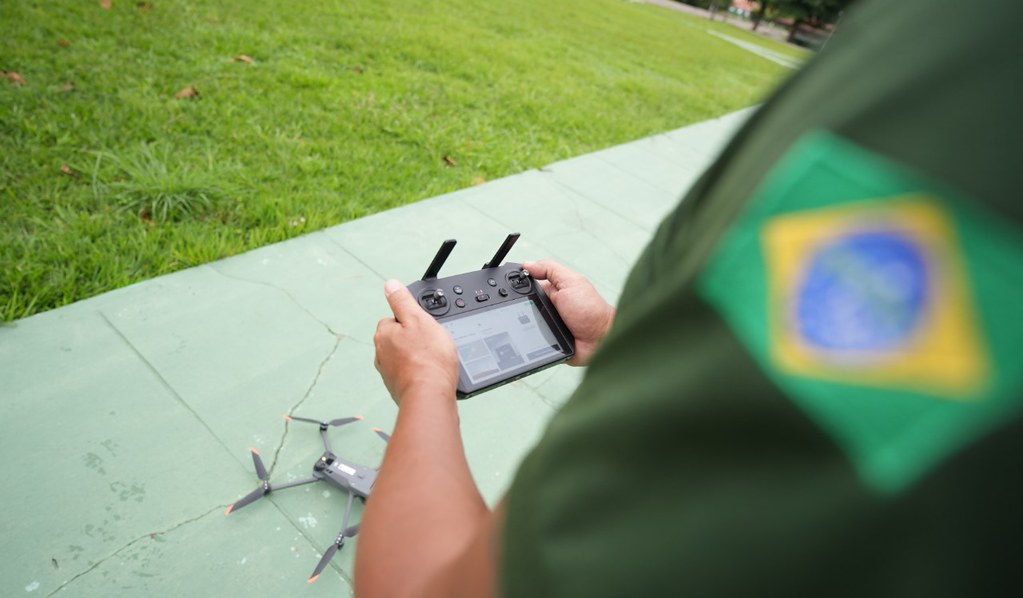- Spurred by a yearlong investigation by Mongabay, a federal crackdown has removed up to 2,000 illegal cattle from Brazil’s Arariboia Indigenous Territory, but faced unexpected protests from some Indigenous residents claiming ownership.
- The pushback has prompted the government to consider regulating Indigenous-owned cattle, raising fears of setting a precedent and inviting the disguised return of illegal herds.
- Indigenous rights advocates warn that legalizing cattle ranching inside the territory could blur the line between subsistence use and commercial exploitation by outside ranchers.
- Despite ongoing surveillance, signs of illegal cattle and deforestation have reappeared, with critics saying the authorities’ response remains too slow to stop renewed invasions.
A crackdown on illegal cattle herds inside the Arariboia Indigenous Territory in Brazil has hit unexpected pushback that could make this the first area of its kind in the country to allow licensed cattle ranching.
That raised concerns among Indigenous rights activists about outsiders once again bringing their illegal herds back into this protected territory, and the environmental damages that would entail.
The Arariboia land, in the Amazonian state of Maranhão, is home to more than 10,000 Indigenous Guajajara and uncontacted Awá — hunter-gatherers who live in voluntary isolation in the depths of the forests and are considered the most threatened Indigenous group on the planet. Spanning an area of 413,000 hectares (1.02 million acres), more than three times the size of the city of São Paulo, Arariboia is a green island surrounded by cattle farms and sawmills, making it one of the country’s most endangered Indigenous lands; it’s also targeted by rising violence and killings of its Guajajara inhabitants.
In February 2025, the federal government launched an operation against illegal cattle and other environmental crimes in Arariboia, spurred by a yearlong investigation by Mongabay that revealed a record-high number of killings of Indigenous Guajajara amid an illegal cattle boom in large parts of the territory. Cattle ranching and other exploitative activities by outsiders inside Indigenous territories is prohibited under Brazil’s Constitution.
By its conclusion at the end of April, the federal task force had removed between 1,000 and 2,000 head of cattle and more than 12 kilometers (7.5 miles) of fencing from Arariboia. It also imposed fines onto offenders totaling 1.1 million reais (nearly $200,000) for environmental crimes in and around Arariboia, task force head Nilton Tubino told Mongabay.

Mongabay’s investigation, published with funding and editorial support from the Pulitzer Center’s Rainforest Investigations Network, was key to the operation: law enforcement agents confirmed all our findings on the ground and said it also revealed details they hadn’t been aware of, including the illegal shifting of the territory’s border markers, now fully reestablished, said Marcos Kaingang, national secretary for Indigenous territorial rights at the Ministry of Indigenous Peoples.
But there’s been unexpected pushback to the crackdown from some Indigenous Guajajara. Initially, the operation aimed to remove “any and all livestock” from Arariboia, Kaingang said. However, this move triggered tension and “a social chaos within the territory”; agents faced strong resistance and protests by some Indigenous inhabitants, who claimed that cattle were key to their livelihood. That compelled the authorities to change their approach, Kaingang added. “It hadn’t been listed as a major focus [of the operation] but it came to be,” Kaingang told Mongabay in a video interview.
For Tubino, “this is the most delicate point” in Arariboia. “During the operation, there were a lot of threats, especially toward those who spoke out against the cattle,” he said by phone, adding there was also a wave of social media posts against the operation and against the minister for Indigenous peoples, Sonia Guajajara, who is from Arariboia.
Tubino, who has led similar operations in several Indigenous territories, said Arariboia’s situation is “unique,” because beyond leasing out parts of their territory to outsiders, some Indigenous individuals had also registered cattle under their names — something that hasn’t been seen in other lands. Legalizing these cattle, he said, is a very sensitive issue, “because if you start putting a lot of cattle” in Arariboia, “there’s going to be a lot of pasture in the region” — which inevitably means greater deforestation.
Graphic by Andrés Alegría/Mongabay.
Kaingang said he’s aware of the sensitivity and complexity of setting a regulation for this cattle, which is why the federal government is taking the due measures and the necessary time to make a decision on it. “We’re being very careful because this could set a precedent for other regions as well.”
When the operation kicked off, Kaingang said, most of the illegal cattle were taken out of Arariboia by the encroaching ranchers, who were afraid of having their cattle seized and forfeited. But now, given the “unexpected” situation of Indigenous Guajajara individuals claiming ownership of some of the cattle, a detailed survey has been carried out across the territory to verify the accurate number of cattle owned by Indigenous inhabitants, Kaingang said.
He added the audited numbers have not yet been released, and a thorough assessment on how to legalize this cattle is being carried out by the Ministry of Indigenous Peoples, along with IBAMA, the federal environmental agency, and Funai, the federal agency for Indigenous affairs.
“It’s never going to be perfect, obviously, but it’s a first exercise that’s going to be done there with the utmost care,” Kaingang said. The aim is to have Indigenous inhabitants’ cattle “minimally regularized, so that we don’t have a lack of control of cattle breeding on Indigenous land” and avoid “opening a gate that we don’t know where it could lead to.”
In an emailed statement, IBAMA said it has notified all Indigenous individuals raising cattle in Arariboia to “start regularizing their livestock activities within a maximum of 120 days,” including the process of obtaining an environmental license. It didn’t provide details about the environmental process to legalize cattle in Arariboia.
Funai didn’t respond to Mongabay’s requests for comment by the time this article was published.
Controversial cattle
Indigenous leaders and activists warn about the complexity of legalizing cattle in Arariboia, saying they fear it will allow the return of illegal cattle back into the territory.
“This is a very challenging agenda within the new reality of the Amazon,” Kari Guajajara, legal adviser at the Coordination of Indigenous Organizations of the Brazilian Amazon (COIAB), told Mongabay by phone. “It doesn’t mean that there can’t be any cattle, because otherwise we’d have double standards,” she added, noting that the legal framework for subsistence cattle ranching in Indigenous territories remains incomplete.

There isn’t specific legislation on the number of cattle that inhabitants of Indigenous territories can raise for their livelihood, she added, but the activity of raising cattle itself isn’t forbidden. “It’s much more in the sense of understanding what the limits are and these realities from the perspective of collective use of the territory [and] how to think about the subsistence of the people of the Arariboia Indigenous Territory from a reality of also taking care of and protecting the environment.”
Kari Guajajara pointed to Indigenous territories in the states of Roraima and in Amazonas, where “there are several territories where we are seeing various cattle-raising initiatives.” She said most of these initiatives are carried out on a small scale, focused on subsistence. Yet at the same time, some of them have been co-opted by non-Indigenous ranchers, who effectively rent out swaths of Indigenous territory for their cattle.
“And it’s very meticulous, there is a fine line between having those Indigenous people who take a stand against [the removal of illegal cattle], for fear of their legal properties being affected, and those Indigenous people who take a stand against it because they were involved to some extent with illicit activities being carried out within the territory,” Kari Guajajara said.
For her, the Arariboia inhabitants’ cattle-ranching activity poses “a very big challenge” to the federal operation to clear illegal cattle from the territory. “How many cattle can you have? How big are the fences?”
Lucimar Carvalho, a lawyer with the Guardians of the Forest, a Guajajara patrol group set up a decade ago to fight against environmental crimes in Arariboia, said she’s very skeptical of government powers to prevent the return of cattle from non-Indigenous ranchers back into the territory. “It’s a questionably delicate legalization, because they won’t have control over which cattle belong to Indigenous people and which don’t,” she told Mongabay by phone.
She said the government is “spending too much time and effort” on an issue that doesn’t reflect the interests of the majority of the Arariboia inhabitants. “On the contrary, it’s being encouraged by a minority that has its privileges, has its benefits from the leases, and then they go after wanting to legalize cattle raising.”

According to Carvalho, the number of Guajajara individuals raising cattle and the size of their herds are small, as they’re just for subsistence. However, several thousand head of cattle were being raised in the territory before the federal operation, through illegal leases paid by outside ranchers to a handful of Arariboia inhabitants.
And it’s this illegal herd that the latter are now trying to legalize, she added, fueling the opposition by some Indigenous people against the crackdown through the use of fake news. “This is an interpretation of misinformation about cattle breeding, and the illegality of cattle breeding. Because at no time is it forbidden to breed cattle by Indigenous — it’s forbidden to breed cattle by non-Indigenous people. And that’s what’s affecting them.”
Illegal cattle coming back?
Tubino, the head of the federal task force, said the initial survey carried out by IBAMA in all Arariboia villages came to almost 2,800 head of cattle, which he called “a reasonably large herd.” In his last overflight of the territory, at the end of the operation, there weren’t this many cattle, he said. That’s because much of the cattle had been taken out by the outside ranchers, raising concerns that the current number includes cattle from those illegal herds.
“We also think that there are people who have declared cattle in the expectation of having the cattle that are out of the territory,” Tubino said. “The cattle there are going to be a difficult issue to avoid turning [parts of the territory] into a big pasture.”
Following the conclusion of the operation, the task force base set up in the municipality of Arame was dismantled and transferred to the municipality of Amarante; another base was set up in Imperatriz to continue monitoring the region and prevent the return of the illegal herds, and also to provide security for Funai agents, Tubino and Kaingang said.
However, Guardians of the Forest patrols have tracked illegal cattle returning to Arariboia, as well as deforestation to make fence posts, Carvalho said. She said they’ve consistently sent photos of these incidents along with coordinates to the task force, but that the response from the authorities takes too long. Carvalho said they claim the need of IBAMA agents on the ground with them to tackle these violations.
“There is a deficiency in this continuity of inspection,” she said. “We send them information, we tell them what’s going on, but they don’t go.” The glacial response, she said, means authorities only arrive in the targeted areas after the crime has been committed and the perpetrators have left.
However, Kaingang said government agents are in constant communication with the Guardians of the Forest, and endeavor to act quickly. He said they respond immediately to most claims, including carrying out joint actions with the Guardians of the Forest. Initially, he added, some adjustments were needed to acknowledge Funai and other federal agents that they didn’t need IBAMA for everything; guidelines were also needed from Funai on what to do in the case of environmental crimes.

Kaingang said they knew there would be attempts to bring the illegal cattle back to Arariboia, which is why authorities will keep two bases operating in the region indefinitely. “It was predictable, we knew they were going to try to put cattle back there or to register it in the name of an Indigenous person,” he said. “They think the operation is over, but it’s not. So we give answers according to the situation that’s happening in the territory.”
Tubino said the operation has concluded and a report sent to the Supreme Federal Court, but added the bases will remain until the community feels they’re no longer needed.
For Carvalho, the solution for Arariboia is “a minimum number of cattle” that can be proven to belong to the Indigenous inhabitants, accompanied by a more intense inspection and the provision of alternative livelihoods that are sustainable.
“That’s the way forward,” she said. “Because cattle farming is the opposite of what Indigenous territories should be doing or being encouraged to do.”
Banner image: Guardians of the Forest pose in front of posters featuring killed guardians. The posters say “State agents are complicit in violence against Indigenous peoples” and “More than 500 years of genocide against Indigenous peoples. No more murders!” Image by Ingrid Barros for Mongabay.
Karla Mendes is a staff investigative and feature reporter for Mongabay in Brazil and a member of the Pulitzer Center’s Rainforest Investigations Network. She is the first Brazilian and Latin American ever elected to the board of the Society of Environmental Journalists (SEJ); she was also nominated Diversity, Equity and Inclusion (DEI) chair. Read her stories published on Mongabay here. Find her on 𝕏, Instagram, LinkedIn, Threads and Bluesky.
Mongabay investigation spurs Brazil crackdown on illegal cattle in Amazon’s Arariboia territory
FEEDBACK: Use this form to send a message to the author of this post. If you want to post a public comment, you can do that at the bottom of the page.
